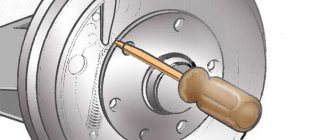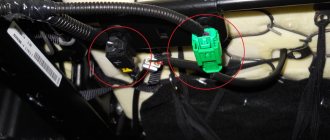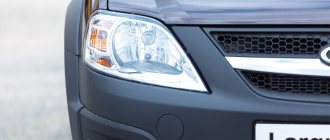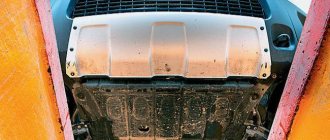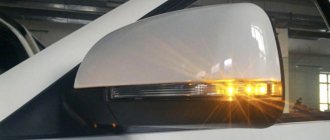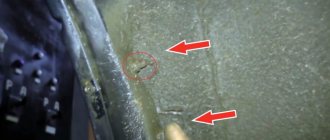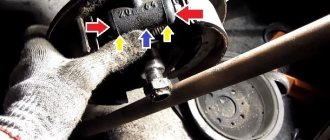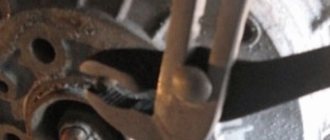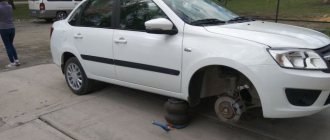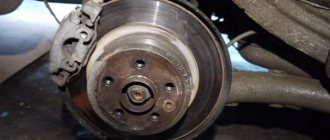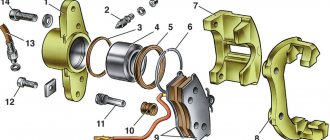Brake pad replacement process
To replace the rear brake pads of the Lada Largus, you need to prepare tools. For work you will need: a jack, a wheel wrench, pliers and a flat-head screwdriver. When everything is prepared, you can proceed directly to the process:
- Engage 1st or 3rd gear at the gearbox.
- Place wheel chocks under the front wheels.
- Raise the rear of the car, where the pad will be changed, using a jack.
- We dismantle the wheel.
- Remove the cap from the brake reservoir.
- We dismantle the top cover of the brake drum.
- We move the working piston inward and fix it in this position.
- We squeeze the sliding parking brake levers inward.
- Compress the spring and unhook the handbrake cable.
- Turn the pressure spring a quarter. In this case, it is worth holding the support stand.
- Now, you can remove the cup, spring and support post.
- All operations described below must be done with the second block in the same drum.
- By stretching the upper spring, we remove the pads from the slots.
- Now, stretch the lower spring and remove the pads from the restrictor plate.
- Next, we dismantle the pads along with the springs.
- We unhook the springs from the pads, first the upper one, and then the lower one.
- Now, it is necessary to dismantle the spacer strips.
- Next, we inspect the drum for defects: chips, grooves, grooves.
- Now that everything is ready, install everything in reverse order.
- If necessary, add fluid to the brake reservoir.
Before using the handbrake, right in the garage, it must be gently pulled and released several times. This will help the new pads adjust.
Removing and installing the rear brake drum of Lada Largus
Tool:
- Electrohydraulic lift type P-3.2G
- Wheel key
- Small hammer
- Mounting blade
- Puller 67.7823-9519
- Driver for socket attachment
- Extension for the end attachment on the wrench
- 36mm wrench attachment
- Calipers
- Metal brush
- Torque wrench
Parts and consumables:
- Brake drum - 2 pcs.
- Brake fluid
- Rags
Removal
1. Place the vehicle on a two-post lift, apply the parking brake, and turn off the ignition.
2. Remove the rear wheel using a wheel wrench.
3. Release the handbrake lever.
4. Raise the car using a lift to a height convenient for performing work.
5. Remove the brake drum nut cap using a pry bar and hammer.
6. Unscrew nut 1 (pictured below) securing the brake drum to axle 3 of the rear wheel hub using a wrench with an attachment and remove the drum with a puller.
Removing the rear brake drum:
1 — brake drum fastening nut;
2 — brake drum;
3 - rear wheel hub axle.
7. Check the technical condition of the drum.
Note:
Brake drums must be of the same diameter. When boring one of the drums, be sure to bore the second drum.
When replacing a brake drum on one side, be sure to replace the brake drum on the opposite side.
When replacing brake drums, be sure to replace the brake pads as described in this article.
8. Using a caliper, measure the inner diameter of the brake drum in two mutually perpendicular directions. Compare the measurement results with the data below. If necessary, replace the brake drum.
— nominal internal diameter of the brake drum is 228.5 mm.
— the maximum permissible internal diameter of the brake drum is 229.5 mm.
9. If there are deep scratches or waviness on the working surface of the brake drum, bore the drum. Take measurements again. Compare the measurement results with the data given above. If necessary, replace the brake drum.
Installation
1. Clean the rear brake components using a wire brush.
2. When replacing a brake drum, check the outer diameter of the brake pads and adjust them if necessary.
3. Install the brake drum onto the rear wheel hub axle and secure it with a nut using a socket wrench. Provide a nut tightening torque of 280 N·m (28 kgf·m) using a torque wrench.
4. Check operation and, if necessary, adjust the parking brake actuator as described in this article.
5. Install the rear wheel using a wheel wrench, tightening the mounting bolts in the sequence shown in the photo below.
6. Press the brake pedal 2-3 times to set the gaps between the pads and the drum, check and, if necessary, adjust the brake fluid level in the brake hydraulic reservoir to normal.
7. Check the effectiveness of the service brake system.
The article is missing:
- Photo of the instrument
Source: https://lada-largus.narod.ru/html/tormoznoj-baraban-zadn.html
Pad selection
The choice of rear brake pads for Largus should be approached carefully, because not only braking while driving, but also how the parking brake will work depends on them.
Original article
7701210109 – this is the original catalog number of the rear brake pads of the Lada Largus. The average cost in the Russian Federation is 5000-5500 per set.
Analogues of brake pads for Lada Largus
There are quite a lot of manufacturers that produce analogues, but we will consider only those that, based on experience, are installed by car owners.
| Manufacturer's name | vendor code | Average price in rubles in the Russian Federation |
| Master-sport | 03-0137-0496-2-SET-MS | 1300 |
| Japan Parts | GF-015AF | 1600 |
| ABS | 9268 | 2000 |
| Meyle | 16-14 533 0016 | 2100 |
| Starline | BC 09890 | 2200 |
| Kraft Automotive | 6025064 | 2300 |
| Pilenga | BS-P 8455 | 2300 |
| TRW | GS 8780 | 2400 |
| Bosch | 0 986 487 754 | 2400 |
| Fenox | BP53009 | 2600 |
| Delphi | LS2022 | 3300 |
| Ferodo | FSB 4031 | 3600 |
| Otto Zimmermann | 10990.154.5 | 3700 |
| FiT | FT3255 | 3800 |
| Valeo | 564 104 | 5000 |
| Ate | 03.0137-0496.2 | 6600 |
All the manufacturers presented in the table produce high-quality spare parts that fit perfectly into the standard Largus seats.
A necessary tool for tightening the handbrake.
Head for 8 for ratchet Set of keys for 13 Partner (preferably the coolest car mechanic)
- Two keys for 13. It is advisable that one of them be a socket.
- Head 8.
- A partner, but you can do without him. The truth is it’s more difficult without him.
The principle of adjusting the handbrake
- Fully lower the handbrake lever in the cabin.
Lower the handbrake handle
- Place the car on a pit or lift it on a lift. Some car owners manage to adjust the handbrake “from the curb” - but this is inconvenient and dangerous.
- Find the resonator from the bottom of the car and remove it from the rubber brackets.
Remove the muffler from its mounting to the body
Using a ratchet, unscrew the 4 bolts securing the protection of the handbrake adjustment mechanism (protective screen).
Remove and set aside the protective screen
Next, you can either remove the protective screen, but it seems to me that it is easier to move it forward behind the muffler, which will free up space that is enough for free work.
Causes of malfunction
The causes of rear brake pad failure are no different from the front ones. But it’s worth dwelling on them to know them:
- Wear of the friction part. It can only be seen if you take the drum apart.
According to the manufacturer's recommendations, the friction part should not be less than 2 mm. For comparison: on the left is a new brake pad, on the right is an old front brake pad - If brake fluid gets on the linings , it also leads to replacing the pads.
- The friction part is cracked , broken off or chipped. This indicates that the pad needs to be replaced.
All these reasons become decisive in the decision to replace the rear brake pads.
Tuning
Many car enthusiasts want to improve the rear brake; to do this, they replace the standard drums with ventilated disc brakes. This operation is done quite simply, but in frequent cases, the hub needs to be replaced.
Installing rear disc brakes
The old rear drums are thrown out and replaced with brake discs, calipers and front pads. This significantly improves the car's braking. These and Sparko offer a full set of rear ventilated brake discs.
As practice shows, disc brakes are 30% more efficient in use, and replacement is carried out in the same way as front brakes. In this case, you do not need to buy separate pads for the rear and front parts. It is enough to buy 4 sets of front pads (each set contains 2 pads).
About the operating principle
The brakes in the Lada Largus turned out to be quite balanced and effective. This is confirmed by a lot of tests. For this station wagon, the manufacturer has provided the possibility of equipping it with the following mechanisms:
- front axle – disc units, which are equipped with the function of ventilation and holding a floating bracket;
- rear mechanisms - drum.
The stern brake components are traditional closed designs that are equipped with mechanisms that allow the pads to self-center. Due to this action, the gap is adjusted.
The pads are driven by a hydraulic system, the actuators of which at the front and rear are brake cylinders with retractable pistons. The entire system is dual-circuit, where the order of distribution of braking force occurs according to a diagonal pattern. The complex also has a vacuum booster.
Many cars today are equipped with a useful ABS system. This mechanism prevents the wheels from locking when the brakes are activated, which is especially important in extreme braking modes, when there is a high probability of skidding.
The parking brake is activated via a corresponding lever located in the passenger compartment. The force on the pads is transmitted by a cable located under the bottom in a special line.
The forums are full of questions regarding modifications of the pads installed on the LADA Largus configuration, both with eight and 16-valve engines. Note that the manufacturer installs different brake mechanisms for different versions of the model, which have their own geometric parameters of discs and calipers. The brakes installed on modifications with 16-valve units are more effective.
What types of brakes are there?
Throughout the history of the automotive industry, 3 types of brakes have been installed on cars:
- tape;
- drums;
- disk.
The first cars had a band brake system. The wheel axle was covered with tape. The driver had access to it at any time. If he needed to slow down, he pulled the tape, and this allowed him to reduce the speed.
Through “evolution,” the band brake was replaced by a drum mechanism. The principle of operation is the simultaneous rotation of a hollow drum with a wheel, which is bursting inside with pads. This slows down the car. This type of brake has proven itself well, but it also has disadvantages. With frequent heavy use, the drum overheats, since the ventilation in this closed system is not the same as that of a disk mechanism.
Just like overheating, moisture getting into the mechanism is also harmful to the drum. When individual parts become wet, the effectiveness of the brakes decreases. If any part in the drum wears out or falls off, it remains inside the system. This is both a minus and a plus. Indeed, in this case, the driver will hear a knock, and it will be possible to take measures to replace the part.
The disc brake system is the most reliable mechanism that eliminates the above-mentioned disadvantages of previous systems. Disc brakes work by rotating the disc simultaneously with the wheel, and when you press the brake pedal, the pads jam the rotation of the disc from the outside. Unlike the drum, the disc is ventilated, so it is less susceptible to overheating than the drum. The discs do not retain moisture and damaged parts. The operating principle of this system is based on the ability to work under heavy loads. Therefore, you can stop your car faster with disc brakes.
Such mechanisms are often front-facing and ventilated. Ventilation holes cover the entire radius of the disc. Some modifications have transverse ventilation holes. With their help, excess heat is removed, weight is reduced and worn parts are removed.
FakeHeader
Comments 28
For some reason, no one writes about rotating the gear wheel before removing the drum. This is written in the book, but it was not possible to do it in practice. I can’t see anything, I had a hard time finding this gear, but it doesn’t rotate!
So is it necessary or not necessary to rotate this wheel first, or just apply more force and the drum will still come off?
I removed the drum several times. Everything is filmed with a bang.
How did you determine that these particular pads are needed?
I sent the person my VIN, and he already looked through the databases and sent me the number.
Well that's great. So you were flying through the air! I don’t mean to offend you in any way, but I don’t believe it and never will.
130000 were like new
